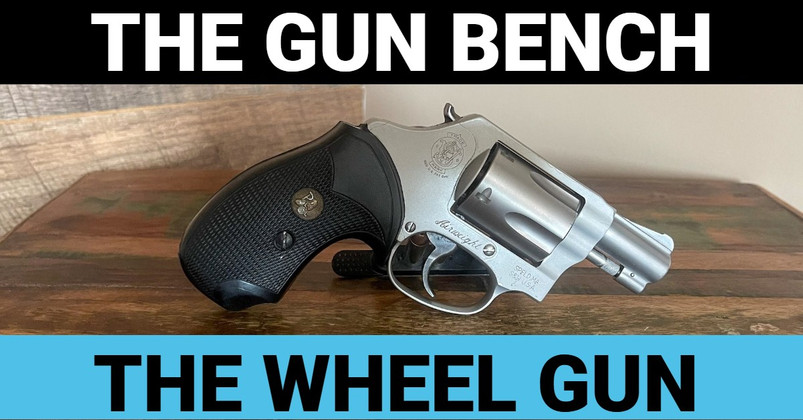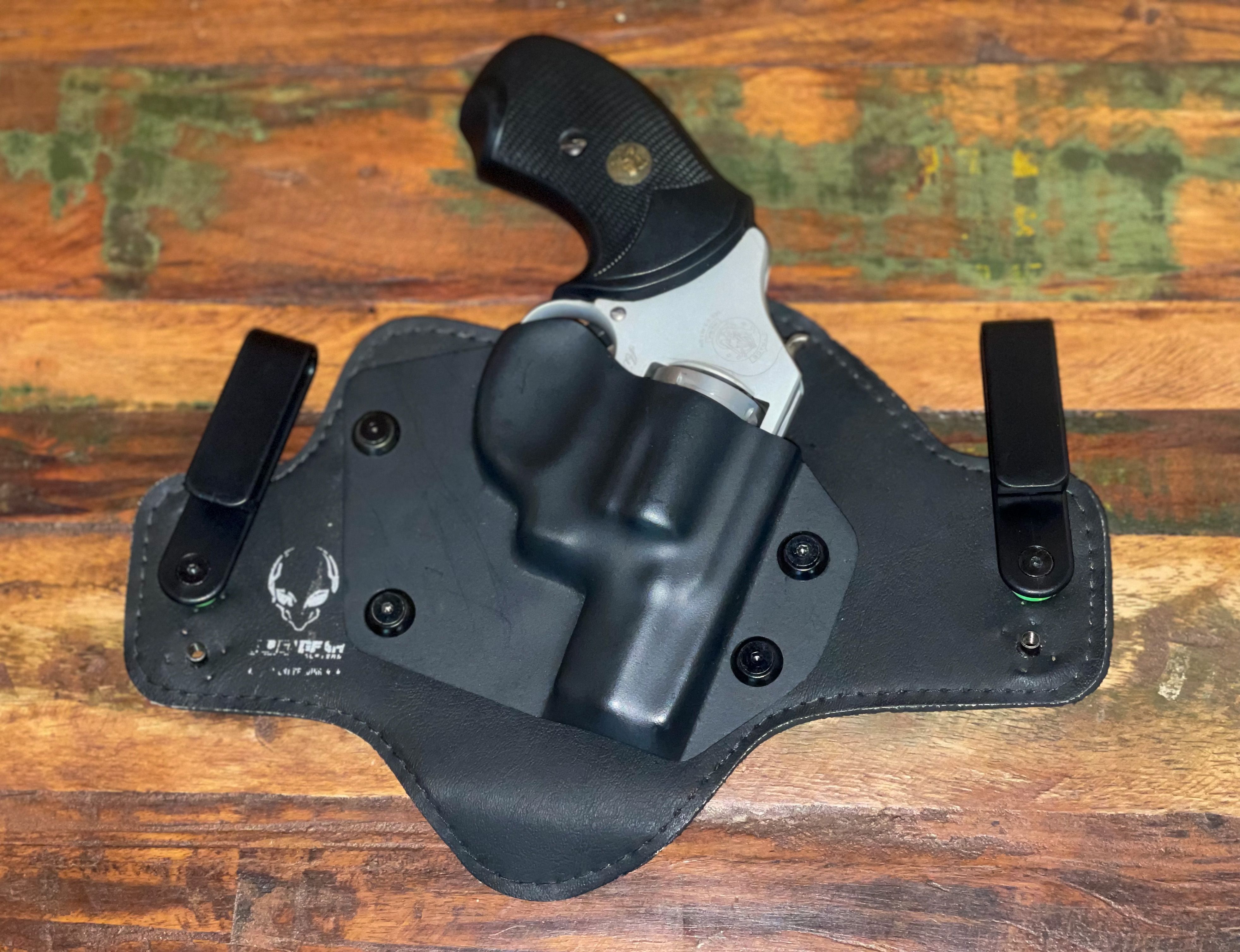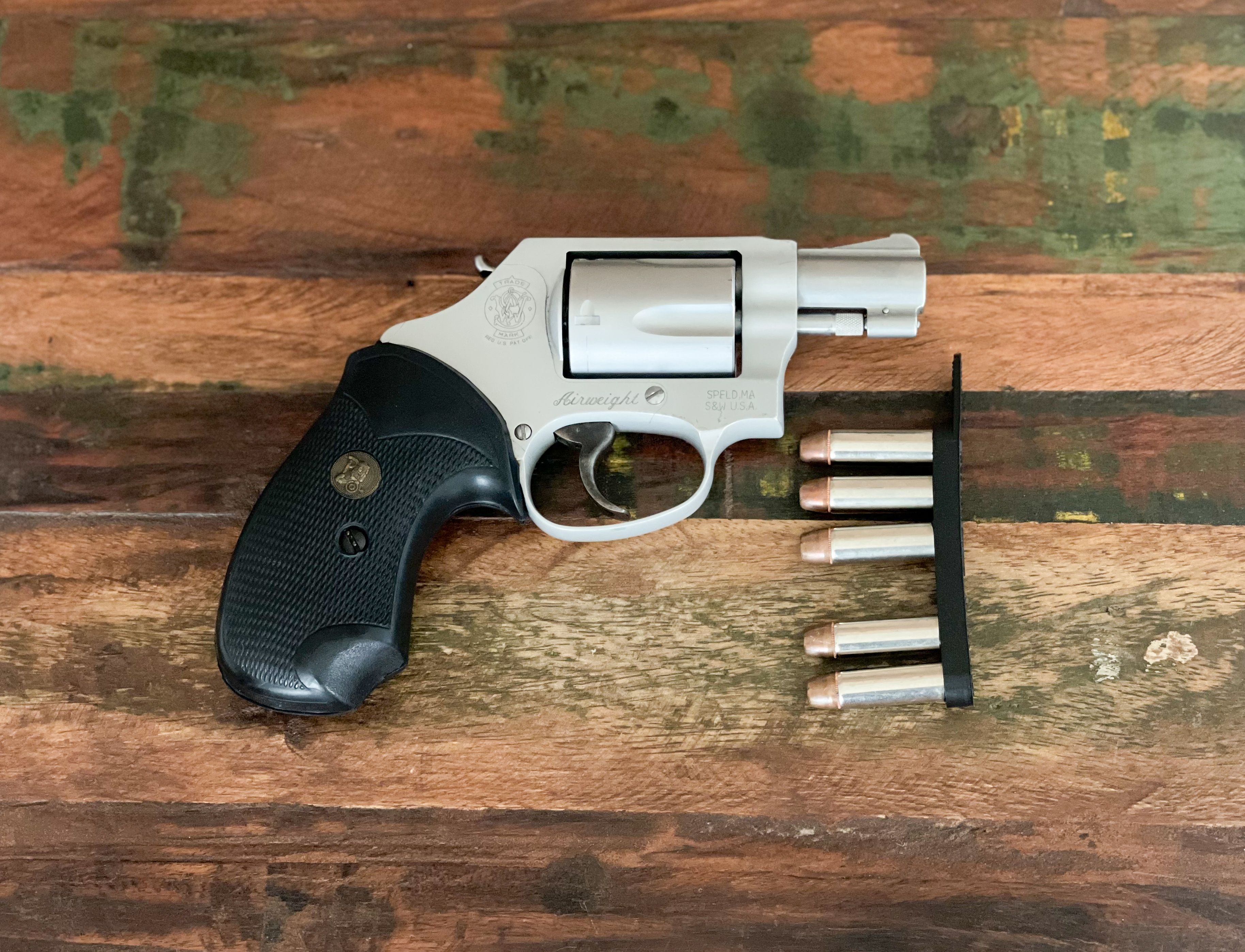The Gun Bench: The Wheel Gun
Posted by SF on Jun 20th 2023
Welcome to the Gun Bench. This is a series where we at Straight Talk bring our readers into the thought process behind how we set up our gear for various roles and scenarios. There is a saying that purpose drives gear. In the gun world, that saying rings clear. With each selection of equipment, there is a purpose—whether it be for hunting, competitive shooting, home defense, or survival—that equipment matters and must stand up to the task at hand. This series looks to help with the thought process behind each piece of kit, so that you, the reader, can have the best available information. One important note, Straight Talk is Ohio based. Some items may or may not be legal in the state you reside in. Also, not every state has Constitutional Carry or Castle Doctrine in place. So please, educate yourself on the laws that you must abide by.
The Curious Case of the Wheel Gun
Americans are infatuated with the revolver, and much like the distinguished Colt 1911, it is a part of our identity. The firearm’s inherent design and history are unique to this continent. People that adore them romanticize with our nation’s past, of the days of Samuel Colt and the untamed West. The revolver’s history as a military arm and police handgun solidifies the firearm on the Mt. Rushmore of guns. Whether it be the revered Colt 1873 Single Action Army or a Smith & Wesson Model 10, the history of the wheel gun is paramount to understanding the history of our nation. But with all its history and romanticized imagery, is the wheel gun still a practical defensive arm in 2023? That is the question that we are looking at today. But we are going beyond that simple question—which there is undoubtedly an unknown amount of discourse found on forums and Facebook pages throughout the internet covering this very topic. Additionally, I will look at avenues on to make the revolver a more adaptable for defense.
Before we start, a note on terms. First, “revolver” refers to the pistol’s functioning action. A cylinder holding ammunition revolves around an axis and is actuated by a system of springs and levers, giving the shooter more than a single shot before reloading. This action is broken down to either single or double. Single action represents that a lever—in this case the hammer—must be pulled back for the cylinder to rotate to a new position while simultaneously setting the trigger. The revolver is then set, and the trigger can be pulled. This process is repeated until all the rounds have been spent. Double action references when the trigger becomes the main actuating point of the gun. The pull of the trigger causes dual action: the hammer to cock and the cylinder to turn. While single-action revolvers usually have phenomenal triggers, double-action ones are much heavier because the press of the trigger operates the mechanisms of the gun. Finally, because the cylinder looks like a “wheel” they are commonly given the moniker wheel gun.
The Downside
So, where does the revolver fit in today’s market? Wheel guns are commonly bought as a defensive arm, though people also collect revolvers or use them for hunting. Commonly, individuals are instructed to buy a revolver, say a Smith & Wesson 637—a small 5-shot .38 special—because it is inherently easier to operate than a modern polymer frame gun. That might be true in some sense but is largely false. Most people unfamiliar with guns and ones that lack strength and dexterity to operate a semi-automatic, view a revolver as a legitimate option, mainly because someone they trust recommended it to them. Let’s look at the reality of the situation. Revolvers, especially small ones, do generate a good amount of recoil, and because of their design, they are a bit more awkward to shoot. The bore axis (the distance between the centerline of the barrel and the shelf of your hand as it grips the gun) sits higher than most conventional pistols, that means the recoil tends to rise in a more vertical direction.
The other issue is trigger pull. I have shot numerous double-action revolvers, especially S&W ones. Generally, the double-action pull exceeds the 12lbs that my trigger-pull scale maxes out at. Not only do you need strong hands to operate the gun, but you also need exceptional dexterity to keep the gun on target while pulling the trigger. Next on the list is reload time. Small-framed revolvers hold between 5 and 6 rounds of 38 Special. The cylinder must manually be “popped” open, and the ejector rod activated. This will spit out the empty cases. Likewise, new rounds must also be loaded manually, one at a time or, if proficient enough, speed strips and speed loaders can be used to expedite the task. All-in-all, the manual of arms on a wheel gun are more difficult than that of a modern polymer gun like a Glock or Sig. One other myth I’d like to eliminate from discussion—revolvers do in fact jam. And when they do, it is typically more catastrophic and requires disassembly to clear. A nice revolver is like a finely tuned watch. The moving parts work in unison to present the best possible mechanical outcome. If any dirt or debris interferes, the operation grinds to a halt.
Negatives aside, why a wheel gun?
Now that revolver bashing is out of the way, why do people still gravitate to them? First off, it’s the romantism of the gun that sparks so much intrigue. Like mentioned above, wheel guns have an aurora of history about them. The American Civil War, the taming of the west, lawmen and gangsters of prohibition, all combine to form a history that is uniquely American. This history centers around a gun that is equally unique. Moving further, wheel guns are a part of popular culture. Western movies wouldn’t be the same without the Colt Single Action Army, nor would Clint Eastwood uttering the line “…this being the 44 Magnum, the most powerful handgun in the world, and would blow your head clean off, you got to ask yourself one question, do I feel lucky? Well, do you punk?” have the same luster without the S&W Model 29. Still, that isn’t the only reason wheel guns are popular. They are plain fun to shoot. A smooth double-action trigger on a Smith 686 chambered in 357 magnum is pure joy. They really become an extension of your hand, and the accuracy is generally excellent. Not only that, but wheel guns can be chambered in calibers that semi-automatics can only dream of. This includes heavy hitters such as .44 Magnum, 45 Colt, 454 Casull, .460 Magnum, and of course, the mighty 500 Smith & Wesson.
People generally buy revolvers to fit a variety of different needs. First, since wheel guns can be chambered is some utterly powerful calibers, the revolver is a mainstay as a hunting arm. In Ohio, for example, handguns that maintain a longer than 5” barrel and are chambered in calibers with a diameter of .357 or larger, can be used in the hunting of deer. Many states have similar laws, though barrel length seems to be ambiguous. Their accuracy and power, coupled with the uniqueness of handgun hunting present a challenge that many hunters desire. Furthermore, wheel guns are used as secondary or a defensive gun in bear country. Lighter-weight guns, such as the S&W Model 69 chambered in .44 magnum are great for carry on a chest holster and are relatively easy to have on you through a tough day of hiking.
Second, people collect them. Whether they want a handsome collection of big bore wheel guns to show off to their buddies or a historical collection to showcase a timeline of military and law enforcement history, revolvers offer variety to a collector. Furthermore, people that have a love for popular culture may acquire certain guns that represents iconic firearms from movies. This includes examples such as the S&W Model 29 or any of the Cimarron Hollywood series guns.
Finally, people still option to carry a wheel gun as a concealed carry weapon. Most common are the Smith line of J-frame revolvers, Ruger’s LCR line, and the Taurus 85 or 856. While it can be heavily argued that a wheel gun is relatively dated for such a task, especially in terms of ammo capacity and ease of carry, there are those that argue in favor of its history, longevity, and track record, which cannot be ignored. The .38 special is a powerful cartridge, especially in +pressure loadings. And with the advent of custom holster manufacturers, carrying the gun has never been easier (but still not the easiest to carry). One caveat, I’d argue the wheel gun takes more time to master than a typical semi-auto 9mm—especially in the manual of arms of reloading, there just isn’t an easy or quick way.
Adapting the Wheel Gun to the Modern Day.
So, by now, you probably think I am a wheel gun hater. That is emphatically incorrect. I love wheel guns and have acquired a nice collection of them. But I recognize their limitations. That is the key part. You can be a collector and admirer but at some point, you must recognize its downfalls. While they might be limiting, there are things that can be done to improve upon them. Let’s start with the most common carry revolver, the S&W J-frame.
My 637—an exposed hammer-fired version of the J-frame—has undergone several modifications to improve it as a carry gun. First, and most notable, the hammer has been bobbed. This means the thumb extension of the hammer has been removed. It no longer protrudes outward creating a hot spot on your skin or something that could snag on clothing. Next, while the trigger was smooth, it was heavy. So, to improve its performance I added a defensive spring kit from Apex Tactical. I find they make some of the best kits to improve the performance of wheel guns. This reduced the double-action pull to about 9lbs. The last piece was the addition of a Pachmyr Compac Grip. This grip offers a relatively aggressive rubber texture. The texture aids in controlling the firearm under reoil. For holster I’ve been using an Alien Gear Cloak 2.0. It carries well at the 5 o’clock position, but for me, it is not as concealable as a modern appendix rig. Finally, I run a Safariland speed strip to carry five extra rounds. It resides in my weakside back pocket. While these upgrades make the gun a better defensive arm, it still lacks compared to by Sig Sauer P365 with 12 round mags and an optic mounted on top. However, with a lot of practice, I do feel comfortable carrying it.
|
|
Final Thoughts
So why do I carry a revolver, then? Because revolvers are cool. More importantly, as a student of the gun the revolver cannot be ignored. Its place in history and popular culture means it is a mainstay within the firearms community. Those that collect or own them respect them. Even those that don’t still admire them. Wheel guns helped write our nation’s history and forge paths forward. In the modern day, they do not hold up against a lot of current pistols, but in certain scenarios they perform well. If you don’t own, get one. Begin the journey of learning the fundamentals of shooting a revolver. If you master it, that will transcend into other shooting disciplines.









